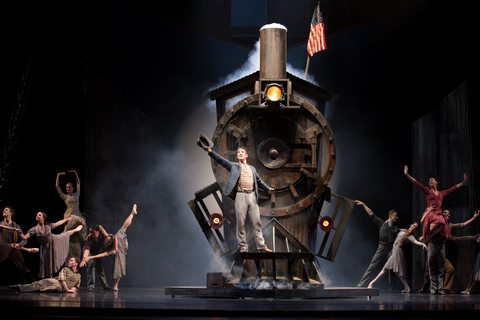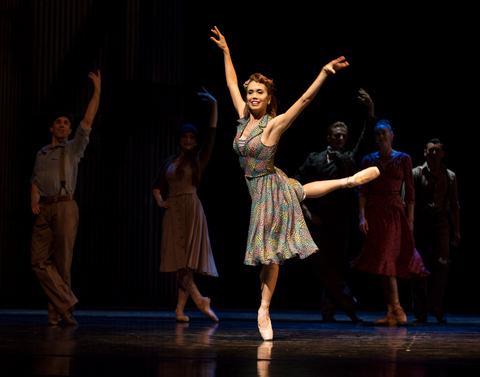Pacific Northwest Ballet 2022
The long-awaited return of a fine West Coast ballet troupe bringing talented dancers and not so fine ballets.

Pacific Northwest Ballet principal dance James Yoshi Moore and company dancers in a scene from Twyla Tharp’s “Waiting at the Station” (Photo credit: Angela Sterling)
[avatar user=”Joel Benjamin” size=”96″ align=”left”] Joel Benjamin, Critic[/avatar]
The Pacific Northwest Ballet has returned to New York, this time under the auspices of The Joyce Theater for a celebration of two anniversaries: the 40th for the Joyce and the 50th for the PNB. This short visit of just six performances only whetted the appetite to see more of this lively troupe, hopefully in a full-length ballet or anything by Balanchine.
For the company’s director, Peter Boal, this short season was a homecoming of sorts. He was a principal dancer in the New York City Ballet which calls the David H. Koch its artistic home. He left seventeen years ago and, since 2005, has been the PNB’s artistic director.
Boal should have put more thought into the ballets he brought, at least those on Program A. Only one of three had heart and emotional depth and was gimmick-free. All three works by established choreographers showed off different facets of the skilled dancers. I am sorry I didn’t see the gala program with the Balanchine ballet, Diamonds.

Former Pacific Northwest Ballet principal dance Noelani Pantastico and company dancers in a scene from Twyla Tharp’s “Waiting at the Station” (Photo credit: Angela Sterling)
Twyla Tharp’s Waiting at the Station, the final work of the evening, was one of her gorgeous messes, this time to bluesy, R & B music by Allen Toussaint played with sass and vigor by a quintet under the astute direction of Emil de Cou.
Tharp, with the help of design genius, Santo Loquasto, took the audience to 1940’s New Orleans where all the citizens seemed to know their basic ballet steps. The twelve-member ensemble zipped about, punctuating virtually every phrase of abandoned dancing with classroom ballet poses or steps which were the heart of Tharp’s step palette.
They were in constant motion, celebrating some unstated event amidst Loquasto’s set: two small structures, one with a clock and a huge upside-down roof that later lowered and opened to reveal, in a real coup de théâtre, an old-fashioned locomotive upon which several cast members stood and waved at the audience.
Three Fates—Amanda Morgan, Sarah Pasch and Genevieve Waldorf—flittered on wearing identical colorful, short costumes (as opposed to the grey street clothes of the rest of the cast) while two spiffy dancers—James Yoichi Moore and Kuu Sakuragi, whirled about trading hats, showing great camaraderie. I assumed they were good buddies, but Tharp’s program notes called them Father and Son.
Two couples—Elle Macy, Joshua Grant, Elizabeth Murphy and Miles Pertl— added some romance to the mix with lovely lifts, light runs and some innocent change of partners.
Waiting is fun but silly and a huge expenditure of steps, costumes and scenery just to entertain. It did have sensationally colorful lighting by James F. Ingalls.

Pacific Northwest Ballet company dancers in a scene from Crystal Pite’s “Plot Point” (Photo credit: Angela Sterling)
Canadian choreographer Crystal Pite’s Plot Point was even sillier, pointless and hard to follow.
Set to Bernard Herrmann’s screechy score to Alfred Hitchcock’s Psycho, Plot Point was a combination detective story, noir film and domestic drama involving Mr. & Mrs. Jones (Miles Pertl and Elizabeth Murphy), Mr. & Mrs. Smith (Lucien Postlewaite and Elle Macy), two Thugs (Ryan Cardea and James Kirby Rogers) dressed in period clothes plus “Replicas” of each and every one of these characters dressed in ghostlike white with masks. (Costumes were by Nancy Bryant and the extensive set that cleverly suggested lonely streets and a suburban house were by Jay Gower Taylor.)
A gun kept appearing and was finally used to kill somebody—who I cannot say because by that point in the ballet nothing was clear. What was in the attaché case passed from character to character? Why the Replicas?
Plot Point was technically well danced but Pite didn’t seem to know whether the ballet was a sly tongue-in-cheek comedy or a heated tribute to Hitchcock and neither did the audience.

Pacific Northwest Ballet dancers Sarah-Gabrielle Ryan and James Kirby Taylor in a scene from Ulysses Dove’s “Dancing on the Front Porch of Heaven: Odes to Love and Loss” (Photo credit: Angela Sterling)
The finest work was the opening ballet, Ulysses Dove’s Dancing on the Front Porch of Heaven: Odes to Love and Loss. Using one of Arvo Pärt’s somber scores (Cantus in Memory of Benjamin Britten from 1977), Dove, a fine dancer/choreographer who left us way too young, created a moving ballet using the simplest of movements.
The cast of six—Cecilia Iliesiu, Armanda Morgan, Juliet Prine, Jonathan Batista, Christopher D’Ariano and James Kirby Rogers, all wonderful—dressed in Jorge Gallardo’s elegant, white unitards, entered and formed a circle in the middle of a central spotlight. (Brilliant lighting by Bjőrn Nilsson, re-created by Reed Nakayama.)
They returned to this circle theme frequently, each time with slightly different movements. When they dispersed to their own spotlights, they performed liquid solos and clinging duets that established emotional connections of longing, quiet passion and sadness. They leaned against each other. They wrapped themselves around each other and tried to pull away, sometimes melting to the floor.
This was a ballet full of emotion, danced beautifully. The dancers were expressive and responsive to Dove’s movements.
The score was conducted by Emil de Cou who never allowed the gongs and eerie, moaning orchestrations to overwhelm the dancers.
Pacific Northwest Ballet at Lincoln Center (through June 26, 2022)
David H. Koch Theater, 20 Lincoln Center Plaza, at 63rd Street, in Manhattan
For tickets, call 212-496-0600 or visit http://www.davidhkochtheater.com
Running time of Program A: one hour and 45 minutes with two intermissions






Leave a comment